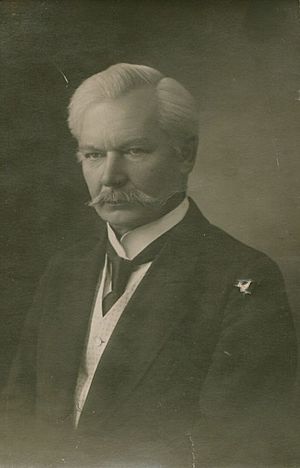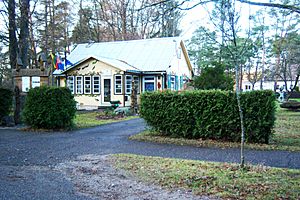Pranas Mašiotas facts for kids
Quick facts for kids
Pranas Mašiotas
|
|
|---|---|

Mašiotas in 1923
|
|
| Born | 19 December 1863 Pūstelninkai, Suwałki Governorate, Russian Empire
|
| Died | 14 September 1940 (aged 76) Kačerginė, Lithuanian SSR
|
| Burial place | Petrašiūnai Cemetery (reburied) |
| Nationality | Lithuanian |
| Alma mater | Marijampolė Gymnasium Moscow University |
| Occupation | Children's writer, educator |
| Employer | Riga Gymnasium Ministry of Education |
| Spouse(s) | Marija Jasienskytė-Mašiotienė |
| Children | Marija Mašiotaitė-Urbšienė Jonas Mašiotas Donatas Mašiotas |
| Relatives | Sister-in-law Ona Mašiotienė Son-in-law Juozas Urbšys |
| Awards | Order of the Lithuanian Grand Duke Gediminas (1928 and 1933) |
Pranas Mašiotas (1863–1940) was a very important Lithuanian person. He was an activist, an educator, and a writer. He is best known for writing and translating books for children.
Mašiotas was born in Suvalkija, a region in Lithuania. His family were farmers. He went to Marijampolė Gymnasium and later studied math at Moscow University. Because of rules at the time, he could not easily find a job in Lithuania as a Catholic. So, he worked in other cities like Łomża and Riga.
In 1891, he became a math teacher at the Riga Gymnasium. He taught there for almost 25 years. When World War I started, he moved to Voronezh. There, he became the director of schools for Lithuanian boys and girls.
After Lithuania became independent in 1918, Mašiotas returned home. He helped set up the new education system. He worked at the Ministry of Education from 1919 to 1923. Later, he led the Lithuanian Gymnasium in Klaipėda. He retired in 1929 and spent his time writing. Pranas Mašiotas passed away on September 14, 1940.
Mašiotas was very active in Lithuanian culture. He joined and helped start many groups, like the Lithuanian Scientific Society. He wrote about 600 articles for newspapers and magazines. He published about 140 books in total. About 30 of these were his own original stories. The rest were translations or based on other works. He mostly wrote children's stories, school textbooks, and science books for everyone. He translated famous children's books like Maya the Bee and Emil and the Detectives.
Contents
Life Story of Pranas Mašiotas
Early Years and Education
Pranas Mašiotas was born on December 19, 1863. His birthplace was Pūstelninkai, near Kudirkos Naumiestis. This area was part of the Russian Empire back then. His parents were farmers. Their home was close to the border with East Prussia. Because of this, they sometimes helped Lithuanian book smugglers. These brave people secretly carried Lithuanian books into the Russian Empire. This was against the rules of the Lithuanian press ban, which stopped Lithuanian books from being printed.
Mašiotas went to a Russian primary school for about six months. But he learned most of his early lessons at home from his family. In 1874, he joined the Marijampolė Gymnasium. He was a very good student and finished in 1883 with a silver medal. He received a special scholarship from the government. This allowed him to study math and physics at Moscow University.
While in Moscow, he became involved in Lithuanian cultural life. He started writing for Aušra, which was the first newspaper in the Lithuanian language. He wrote ten articles for Aušra. In these articles, he spoke out against the Lithuanian press ban. He also criticized other policies that tried to make Lithuanians more like Russians. He even gave helpful advice to Lithuanian farmers.
Teaching in Riga
In 1887, Mašiotas returned to Lithuania. However, because he was a Lithuanian Catholic, he found it hard to get a job. This was due to the government's policies at the time. He took a temporary office job in Łomża, Poland. In 1889, he moved to Riga, which is in Latvia.
He first worked as a clerk in an education office. Then, in 1891, he became a math teacher at the Riga Gymnasium. He stayed in this job for nearly 25 years, until World War I began. From 1913 to 1915, he also directed a private girls' school in Riga.
Mašiotas was very active in the Lithuanian community in Riga. Many Lithuanians moved to Riga for work. By 1913, over 35,000 Lithuanians lived there. He helped organize different Lithuanian groups. One group, the Lithuanian Benefit Society, held cultural events to help Lithuanians in Riga. He also chaired the Žvaigždė Society for about ten years. This society opened six Lithuanian primary schools and offered evening classes for adults. He often worked with Marcelinas Šikšnys, another Lithuanian math teacher.
Mašiotas also took part in cultural and political events in Lithuania. In 1902, he helped start the Lithuanian Democratic Party. He was chosen to be on its main committee. During the Russian Revolution of 1905, he attended an important meeting called the Great Seimas of Vilnius. In 1905, he joined a committee to create the Lithuanian Scientific Society. This society officially started in 1907. He even shared his photos of Lithuanian culture with the society. Some of his pictures were shown at a big international exhibition in Paris in 1900.
Mašiotas wrote many articles for Lithuanian newspapers. Before 1904, when Lithuanian printing was illegal, he wrote about 70 articles. After printing became legal, he wrote about 200 more. His articles often talked about education, the Lithuanian language, and social issues. Thanks to his efforts, a newspaper called Lietuvių laikraštis started a special section for children. Mašiotas published his stories and translations there.
Working for Independent Lithuania
When World War I started, Mašiotas helped Lithuanians affected by the war. He worked with Juozas Tumas-Vaižgantas in Riga for the Lithuanian Society for the Relief of War Sufferers. In 1915, as the German army got closer to Riga, Mašiotas moved to Moscow and then to Voronezh. There, he became the director of Lithuanian schools for girls and boys.
At the same time, Mašiotas worked on writing math textbooks. There were no standard Lithuanian math words. So, three mathematicians (Mašiotas, Marcelinas Šikšnys, Zigmas Žemaitis) and a language expert, Jonas Jablonskis, worked together. They created standard math terms and a Lithuanian math dictionary. Mašiotas also took part in Lithuanian politics in Russia. He became vice-chairman of the Supreme Lithuanian Council in Russia. This group represented the Lithuanian nation.
He returned to Lithuania in 1918. He immediately started helping to organize the new Lithuanian education system. He worked for the Council of Lithuania and later at the Ministry of Education. He was in charge of higher education and also served as vice-minister. He wrote many articles about how to set up different schools in Lithuania.
In 1923, Mašiotas became the director of the Lithuanian Gymnasium in Klaipėda. This was after the Klaipėda Region became part of Lithuania. He retired in 1929 to focus on his writing. His wife, Marija, typed his handwritten works. His son, Donatas, helped get them published. His articles appeared in many Lithuanian magazines and newspapers.
Mašiotas received the Order of the Lithuanian Grand Duke Gediminas in 1928 and 1933. This is a high honor in Lithuania. He also received an honorary doctorate from the University of Lithuania in 1923. He was made an honorary member of the Society of Lithuanian Writers. In 1934, a street in Kaunas was named after him.
An architect named Vytautas Žemkalnis-Landsbergis designed Mašiotas' house in Kaunas. Mašiotas lived there from 1929. After Lithuania came under Soviet control in 1940, his house was taken. He moved to Kačerginė to live with his son. His daughter, Marija Mašiotaitė-Urbšienė, and her husband faced difficulties. Pranas Mašiotas passed away on September 14, 1940, at 77 years old. His funeral was a big public event. He was later reburied at the Petrašiūnai Cemetery.
Pranas Mašiotas' Works
Mašiotas wrote and published many books. These included books for children, school textbooks, and popular science books. He published about 140 books in total. About 30 of these were his own original stories. He also wrote around 600 articles for different Lithuanian newspapers and magazines. Before 1904, when Lithuanian newspapers were illegal, he used about 50 different pen names to hide his identity.
Mašiotas is most famous as a children's author. Some people call him the "father of Lithuanian children's literature." Before him, most children's books were religious or just taught lessons. In 1894, Mašiotas wrote an article saying what good children's books should have. He believed they should be beautiful, educational, and teach good values. They also needed to be written in correct language. These ideas were very important for future writers. His later works and translations focused on teaching children about things like nature.
His stories were collected in popular books like My Little Gift and Old Man's Tales. These stories teach good values without being too preachy. Some of his books, like I Too Was Little and When Books Were Banned, tell his own life story. They talk about the Lithuanian National Revival and the time when Lithuanian books were forbidden. In 1938, I Too Was Little won a literary prize. His short stories often have realistic characters. They focus on logical thinking rather than just feelings. His travel books describe Lithuania's nature. They also include facts about geography, history, and culture. These books were for students to make them interested in their own country.
Mašiotas translated books by many different authors. These included famous writers like Daniel Defoe, Erich Kästner, and H. G. Wells. He started translating when he taught Lithuanian on weekends in Riga. He would give students Russian or German texts to translate. This made him interested in translating himself. He often changed or shortened texts to make them fit better for Lithuanian readers.
Mašiotas wrote his first math textbook in 1905. It was a book of math problems. It became very popular and was printed 14 times. He also published other textbooks on topics like trigonometry, history of math, and algebra. He wrote a physics textbook and two books on how to write. These textbooks were made quickly to meet the urgent need for Lithuanian-language school books.
He also wrote several popular science books for children. These included Conversations about Sky and Earth and How People Took Over the World. His Science Tales were first published in 1916. This book has eight stories where a teacher explains physics laws to shepherds. He uses everyday language and simple experiments. This made learning science fun and easy to understand.
Pranas Mašiotas' Legacy
Since 1969, Mašiotas' books and translations have been republished in a series called "Little Library of Pranas Mašiotas." By 1983, this series had 37 books, and by 2009, it had grown to 50 books.
His daughter, Marija, wrote her memories about Mašiotas in 1982. A book listing all of Mašiotas' works was published in 1990. In 2013, on his 150th birthday, the Lithuanian post office released a special stamp in his honor.
Three schools in Lithuania are named after him: one in Kaunas, one in Vilnius, and one in Klaipėda. Several streets in Lithuania also carry his name. A memorial stone was placed at his birthplace in 1990. In 2001, Mašiotas' granddaughter gave his house in Kačerginė to the town. She wanted it to become a museum about the Mašiotas family. In 2004, artists created sculptures for a Fairy Tale Park around the house, inspired by Mašiotas' stories.
Since 1993, an annual seminar about children's literature in Lithuania is held in Mašiotas' honor. In 2012, an award for the best Lithuanian book for children and teens was also named after him.



